Role-Play Training: The New Foundation for the Training Industry, by Clark Aldrich

Role-plays, Short Sims, or scenarios are learning experiences that mirror the real world and help people learn things the same way they would in real life but in an easy, safe environment.
Think of them as a “Groundhog Day” situation. Learners, like Phil (Bill Murray), make choices over and over until they get them right.
To dive deeper into this topic, we talked to Clark Aldrich.

Clark Aldrich, Founder and Managing Partner of Clark Aldrich Designs
Clark Aldrich is the world’s most experienced designer of educational simulations, creating Short Sims for clients, working across industries, from Visa and Sony to the Department of State, Harvard Business Publishing, the United Nations, Microsoft, the Bill & Melinda Gates Foundation, and the Center for Army Leadership.
Mr. Aldrich shared his insights about existing types of role-plays, their benefits, and limitations, and helped us create a step-by-step guide to building effective role-plays.
Here’s an example of a Short Sim he created with iSpring Suite. Check it out to get an idea of what role-play is and how it works.
And now, let’s see what Mr. Aldrich has to say on the topic.
Role-plays, Short Sims, scenarios… what do we call these things?
It’s funny that we’re all stuck on what to call these experiences. One company calls them “rehearsals,” another refers to them as “simulations”, and even “learning games.” “Scenario” is probably the term that most clients prefer. iSpring uses “role-plays” and “role-play simulations.”
I call what I create for clients and teach to organizations “Short Sims.”
In my book, Learning by Doing, I identified four common types of educational simulations:
- Branching stories;
- Virtual products;
- Systems simulations; and
- Game models.
Short Sims are the result of a 15+ year effort to combine the best elements of these 4 types.
Ultimately, it doesn’t really matter what you call them if everyone involved understands what you mean. I would rather show examples of my work than rely on any term. In this article, I’ll use role-plays, role-play training, sims, and Short Sims interchangeably.
What’s Wrong With the Current Training Foundation?
There is a common complaint in the industry that training gets little respect from the rest of the organization. Most employees will put off most training as long as possible. Sponsors think it’s too expensive, too ineffective, and takes too long to create.
There are three reasons for this.
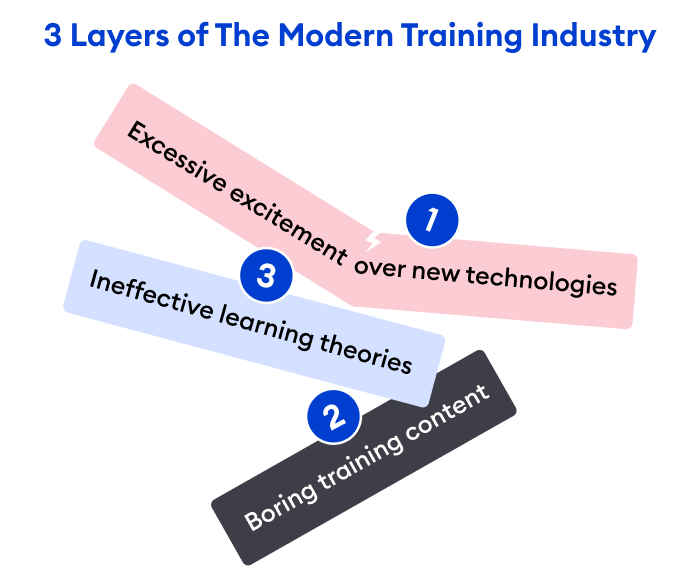
1. Excessive excitement over new technologies
The training industry gets far too excited about new consumer technologies like ChatGPT, gamification, and the metaverse. We invest our very, very precious discretionary time, energy, and money in technologies that require a user base of millions and highly skilled specialists to implement. Cynically, this hyping tends to be done by consultants, conferences, and magazines to cash in on trends quickly, happy to suck up our investment budgets and time.
However, the underlying yearning by the training community for something better is right on target. We get seduced by these pipe dreams because we realize the old stuff doesn’t work.
2. Boring training content
Today, as it has been for decades, most of the training content created and delivered by a training department is some version of a PowerPoint lecture or a PowerPoint-style workbook. The content is based on an expert dumping information on the learner. As an industry, we dream big but deliver small.
These are things that we know don’t work very well, but we create them anyway because we’re used to doing them. No one has ever gotten fired for creating a workbook. They are predictable to create, audit, and deploy.
3. Ineffective learning theories
The industry is lousy with learning theories. PhDs seem to push new learning theories one year, and then shoot them down the next. New learning theories tend to either try to anticipate future technologies that never emerge, justify traditional content as worthwhile, or both.
And so, we have these three layers of dysfunction. It’s great for people who talk and write for a living. They get credit for being future focused while role-modeling the same old lectures and articles. But then we’re surprised when no one takes training seriously, and no one respects the industry. We’re producing pretty dreary, dated content of low effectiveness, and it’s hard to get out of our industry echo chamber.
How Role-Plays Help
Role-plays give us a way to move forward. They get us from this old bad overshooting and under-delivering content cycles to something sustainable. Sims combine the good of revolutionary innovation with the good of sanity.
Simply put, there are two ways we learn in life. Yes, we learn from being told. But we also learn by trying, and then, if we fail, we try something else. If you turn the doorknob and it doesn’t work, you try turning it the other way. Or you push. Or pull. If you’re a new manager and are too vague with instructions given to a new hire, you learn to be more specific next time. If you’re experienced at innovation, you learn how to interpret short-term failures.
Perhaps the perfect way to learn is by doing something worthwhile that lines up with the real world, and very judiciously receiving some friendly guidance when we get stuck. This is what we can do with Short Sims.
When most people think of simulations, they think of very high production values, very long turnarounds, and probably computer graphics that look twenty years old. So, when learning specialists realize that role-plays can be done simply, they’re shocked. Helping people grow is the reason they got into this industry. I hear people say variations of, “Wow, we can create something that people actually like; something that feels helpful and relevant, in about the same time as it took us for the old workbooks.”
Role-plays empower you to teach soft skills that you simply couldn’t teach before.
Here is the question for everyone in education: How do you teach leadership to new employees at a large corporation? Or, how do you teach leadership to a class of college students?
Do you give a lecture? Hand out a book by a famous leader? Give out five workbooks? Set up a mentorship? Give them wordy and complicated branching stories?
Also read: Mentorship Program: All You Should to Know in 2023 [Expert Insights]
Every single traditional methodology we have available for consistently teaching leadership is going to stink – and we all know it.
Until now. Short Sims provide a breakthrough for teaching these skills.
In leadership Short Sims, learners can go through typical leadership situations. They can experience situations that play through one or two aspects of leadership. The point is simplicity, not complexity.
In one, leaders can make a series of decisions over the course of a week to see how to best influence the employees who report to them. They can learn that role modeling is absolutely necessary and is more influential than what a leader says, for example. And they practice this behavior in more nuanced situations. This means that we can get new managers thinking in terms of hierarchies in just a few minutes in a short, scalable experience without the need for expensive and inconsistent instructors. This is amazing. (I’ll show you an example of how we visualize this later on.)
In another Short Sim, we can get managers thinking about their team, and how different management approaches are necessary for different team members. These are not high stress or high complexity sims – two aspects that distract from learning. Learning should be satisfying and empower the learner, not exhausting them.
So before Short Sims existed, when asked how to teach leadership, most people were flummoxed. After seeing Short Sims, most people agree the way to start the process is through sims.
Short Sims are so natural that most people don’t see how revolutionary they are. It is so unfair that the hard work on the part of the designer to make things simple is taken for granted by the learner! (That’s when you know you have succeeded, of course. It is not until people try to build their own that they start realizing the depth of the pedagogy required.)
And this is how we save the industry – by getting people away from their addiction to bullet points and PowerPoint slides and into something that is infinitely more useful, but still straightforward to create, audit, and deploy.
Are Role-Plays Better for Training or Assessing?
The obvious answer is both. Many clients order Short Sims for both roles. The pedagogy is slightly different.
I personally like building training sims more than I like building assessment sims. I love growing the skills of the players. But while it is revolutionary to rigorously teach leadership, it may be more revolutionary that we can test leadership predictably and at scale.
For all topics, sims are surely better for assessment than standard multiple-choice questions. I spent a bit of time developing the Short Sim pedagogy with ETS (Educational Testing Services), and needed to create an approach that was fair, auditable, easy to deploy, and even consistent with a test item philosophy. As a result, Short Sims handle broader and more complex test-taking situations, such as giving partial credit for multi-stage challenges.
Limitations of Role-Play Training
If you’re running a flight simulator and want your pilots to learn how to land an airplane in a snowstorm, Short Sims can only have introductory benefits. They can teach you some of the strategies.
Military flight simulators, medical professions, and such, are areas where huge amounts of money have been spent on extremely expensive simulations. Short Sims do have a role to play: they should be the first thing you give to learners to get them started. But they aren’t going to give you fine motor skills.
Beyond that, the limit of role-play training is your imagination.
Probably the biggest limitation of Short Sims is on the part of the designers. Specifically, the previous generation of instructional designers and teachers are the ones who are going to have the hardest time being clever and creative with Short Sims, wanting to go back to the old way of doing things – like just telling people the one right brittle path to success. It is the current generation for whom this is, using the Steve Jobs quote, “A glass of ice water in the desert.”
In any case, the most important first step for anyone interested in Short Sims is to see a few great examples. The first thing I do in my workshop is to have students play a few and then discuss what they liked and what they did not.
5 Types of Role-Play Simulations
One starting point is to see the variety of roles that sims can take. People who only see one sim tend to imprint upon that single use.
Across hundreds of client engagements, I have identified five major types of role-play simulations to build. They range from soft skills to certification skills. Let’s take a look at each type, so you can figure out which ones are most useful for a specific case.
Interpersonal processes (with clients, patients, and coworkers)
Probably the best-known type of role-play is asking learners to use conversions and other actions to implement a process with a single person. Call centers, doctors, client-facing services, and the hospitality industry – wherever you need to train people on how to engage with other people most effectively – this type of role-play is a good fit.
The earliest examples of such role-plays are what I called “branching stories” in my book Learning by Doing, and the name stuck. These are when a learner faces a situation like an angry customer and is given a variety of options on how to behave, and what to say, in order to resolve an issue.
Such role-plays have been popular for quite some time. Most examples I studied, however, were both too wordy and unnecessarily vague and complex. Learners were more likely to leave muddled.
With just a few tweaks, however, we can now make them richer to cover a wider variety of situations, and clearer.
For a bank that needs to teach the staff how to work with older clients, I developed a Short Sim in which a learner first interacts with an elderly client while they’re in good health and then 9 months later, during which the client had grown much older.

I also introduced other characters, such as the client’s daughter with suspicious motives.

Now you are talking with two characters, learning from the relationship between father and daughter, deciding if laws are being broken, and how to bring in help if needed. These techniques, including the use of fast forwarding in time, minimal text, and clear decisions, are more engaging than a standard role-play with standard response options, and are on an entirely new level as compared to the workbooks that most companies use to train their teams.
Dynamic interpersonal skills (such as leadership).
The second type of role-play focuses on dynamic interpersonal skills, such as leadership. This is also in the area of interpersonal skills but with less formal rules and more judgment. The assumption is that learners need to learn the content in a way that they can improvise and adjust in the real world – not just follow policies.
This approach is mostly experiential, with the theory integrated into the graphics and design. (Nobody wants their medical doctor or pilot to only know the theory, and nobody wants to work under a person who has never managed people before.)
Instead of lecturing people about leadership – what leaders need to do, what they shouldn’t, etc. – we create examples of the challenges that they’ll soon be facing.
Here’s that moment from a leadership sim (below). The player has to decide whether to send out an email on work-life balance to their team right now (at 8:00 PM) or wait until morning. If they send it now, their actions will contradict the essence of the email and have the opposite effect.
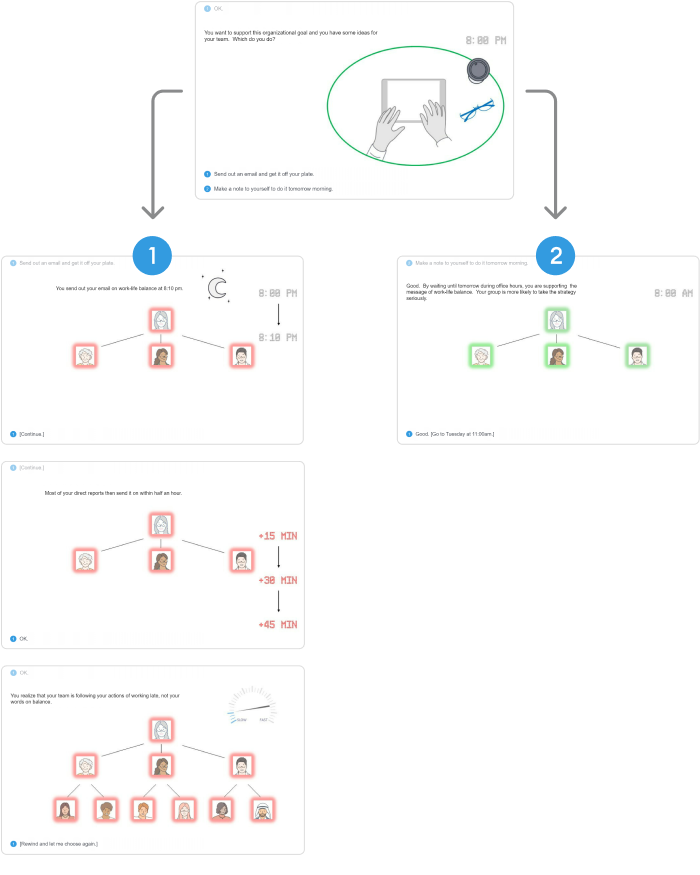
These Short Sims share an interface of branching stories, but the content focuses more on dynamic systems, and the interface is more visual and gamelike rather than wordy. Once again, we have designed an interface so elegant and powerful that players don’t even realize they are thinking about it and seeing the impact of their actions throughout the organization.
To get a better idea of how this type of sim works, check out another example of a role-play on leadership skills:
Certification skills using props
Another kind of sim is about certification skills. These role-plays help learners develop specific, more practice-related skills.
For example, if you work in a government organization, you can train people on how to work with documents.
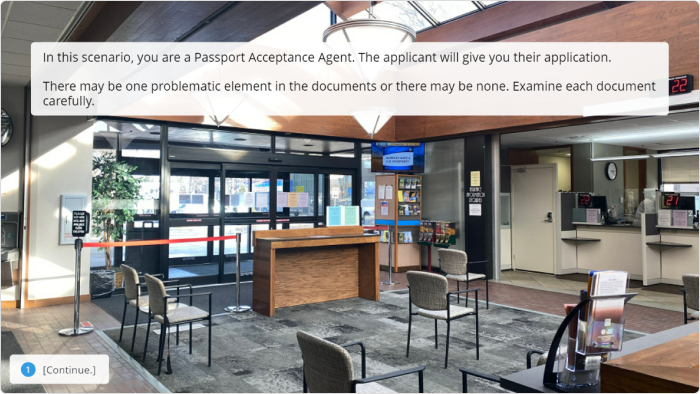
Learners meet applicants and are to check their documents for mistakes and other problematic elements.
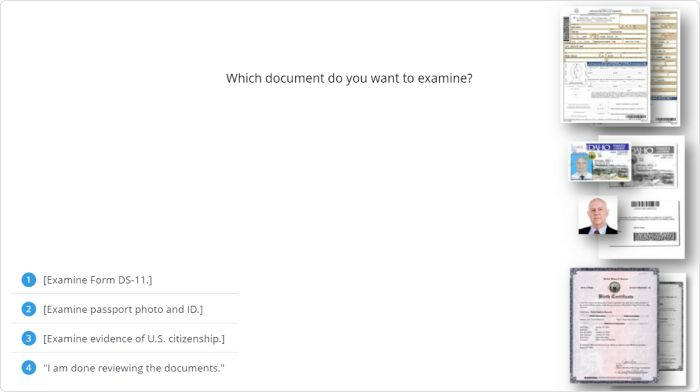
They can scroll down documents, zoom in or out, flip to another page, go back and read it over, and then examine other documents.
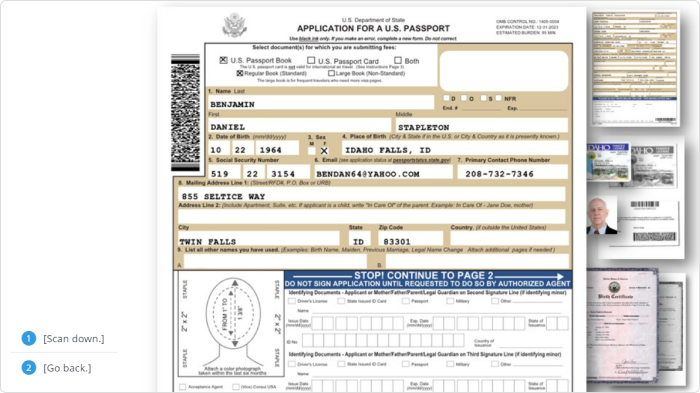
These sims may use a less wordy version of a multiple-choice interface, but they’re designed and created more as the sim type of ‘virtual products.’
The result is that you can completely replicate what used to be an incredibly expensive training process. There’s no need to create actual printed sample documents (and recreate them when someone spills coffee on them or tears them, and so on) – just design digital versions of these docs once and use them ever after. People can learn quickly and very efficiently, getting a feel for the real-world process, while your organization saves effort and money.
Again, this is enabled by an elegant visual design and logic that needs no special training on the part of a learner on how to use it.
Activities in physical space using isometrics
The fourth type of sim uses isometric graphics in safety training. This sim type borrows visual elements from computer games and focuses the player’s attention on the setting.
If you’re returning to the workplace post-COVID, how do you navigate the hallways and meeting rooms? If you’re on an oil rig and everything is on fire, how do you escape?
Or how do you deal with a hostile robbery situation? For example, in this Short Sim on hostile robberies, learners need to make decisions, most of which relate to the surroundings, such as where to park a car when you are opening up a bank or what you should do first when the robber leaves: set off an alarm or lock the door.
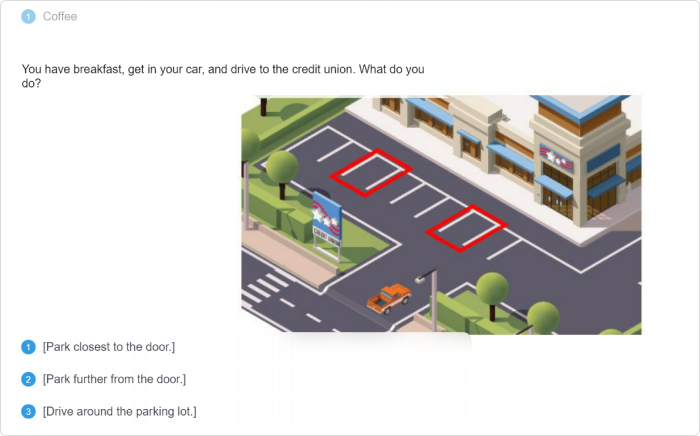
Abstract relationships using conceptual props
The final kind of sim is even more game like and conceptual. It’s perfect when you need to teach people things like mathematical concepts and relationships. In other words, something abstract that can be difficult for some learners to follow and digest in a purely theoretical form.
In order to not describe it too abstractly, let’s look at an example. I made this sim below for a series I did with the Bill & Melinda Gates Foundation, and it teaches people how the demand curve works.
A learner owns a food truck and changes the prices of drinks to see how it affects demand.
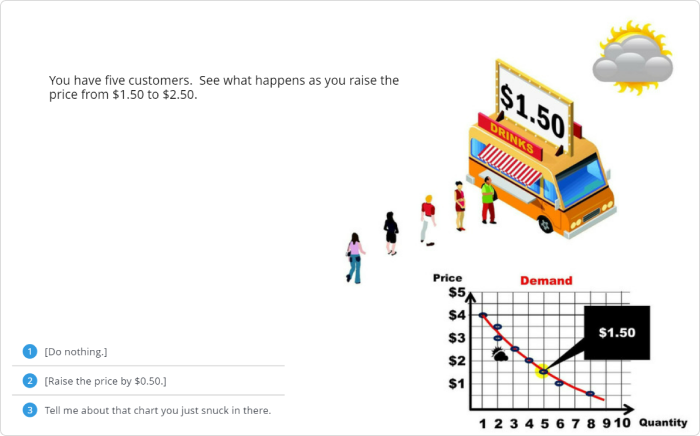
They can also change the weather to create a second demand curve. (When the sun comes out, more people are willing to buy drinks at higher prices.)
There are “sandbox games,” as I used to call them in the early gamification writing I did when at Gartner in the late 1990s. Now they can be used as sims in corporate training. They are informative, illustrative, and engaging.
The hardest part of the design was coming up with a simple example of a demand curve in action, and how to layout the screen.
7 Steps to Create an Effective Role-Play
With practice, you should be able to create an entire role-play in about 40 hours over two weeks. If you are going over that, you’re probably overthinking or over-executing it. Remember that you need to keep it simple.
Here is a high level of the process I teach my students in my Short Sim workshops to create a sim from scratch.
Step 1: Pick a topic and narrow it down
1 hour
Pick a topic for your sim. Narrow it down, and narrow it down again. Where are people who need to know how to do something or who are doing something wrong? It can be tactical or strategic.
Step 2: Interview an SME / Review the recording
1 hour / 3 hours
First, ask a subject matter expert (SME) questions about the correct way of doing something. For example:
- How do you delegate authority?
- How do you allocate resources in a dynamic situation?
But what’s even more important is to ask the SME about common mistakes. In the real world, where do people make mistakes when applying this? If you’re landing an airplane in a blizzard in the mountains, where do pilots make mistakes? If you are a first-time manager inheriting an unhappy team, where do most people make mistakes? Then ask, “Why do people get this wrong?” What are the wrong goals, or the incorrect understanding of the situation?
Step 3: Create a high-level structure
7 hours
Once you identify the right way and common mistakes, you can build your sim around them. Your goal will be to come up with a specific situation that allows learners to play through one example, complete with the opportunity to make these common mistakes. When they make a common mistake, they can learn from it quickly and then get to make that choice over again.
To do that, follow these steps:
- Ask yourself, “What is a simple situation that represents the content?”
- If you can, break that simple situation into three or four sections of the experience. (For a sim on group problem solving, the three sections might be: prepare for a meeting; understand the problem in the meeting; solve the problem in the meeting.)
- For each section, write down where people commonly make mistakes.
For the setting of the sim, make sure you can articulate the setup to your players in the form of “You are a __ and you have to __.” (For example, “You are an experienced manager and you have to help an underperforming team member.”) This approach helps you give a player a clear idea of the game’s rules from the very beginning.
You can do all of the above in a simple word document.
At this stage, you’ll need an authoring tool to start developing your sim. There aren’t many options that help you design this type of content easily. And the perfect tool for doing this is iSpring TalkMaster, which is included in iSpring Suite.
I have spent more time making sims with iSpring TalkMaster than anyone. I promise you there are no better tools in the world for creating role-plays.
Once you’ve done all of the above, create a linear storyboard that includes all of the steps and all of the common problem decision points. You can do this right in iSpring Suite. The sim development process in Suite is intuitive and illustrative, and will save you a step compared to doing it anywhere else.
After that, you need to start building out the actual rough decisions by inserting branches. Use caveman English at this point – you’ll have time to polish the language later on.
So, if a common mistake is described by a subject matter expert as: “When a bank manager opens a bank in the morning, they may not be aware of their surroundings. A bad guy can be lurking about and force them to open up the bank at gunpoint, which is called a ‘morning glory robbery.’”
The placeholder rough decision may be:
You have to open the bank. Do you:
A. Just focus on opening up the bank. (wrong)
B. Look around the parking lot for bad guys. (right)
We will smooth that out and make it more interesting later on (which, of course, turned into the example above.)
After laying out the storyboard and rough decisions, you should be able to click through your entire Short Sim. It may be ugly, but it all works.
How to do this in iSpring Suite
Here are step-by-step instructions on how to do the practical side of this stage in iSpring Suite.
1. Open iSpring Suite. If you don’t have a subscription yet, download it and get started for free.
2. Click Role-Play on the iSpring Suite tab.

3. In the opened window, select New Role-Play. Then click New Scene.

4. In the pop-up window, create your scene by adding a character, a background image, texts, and reply options.
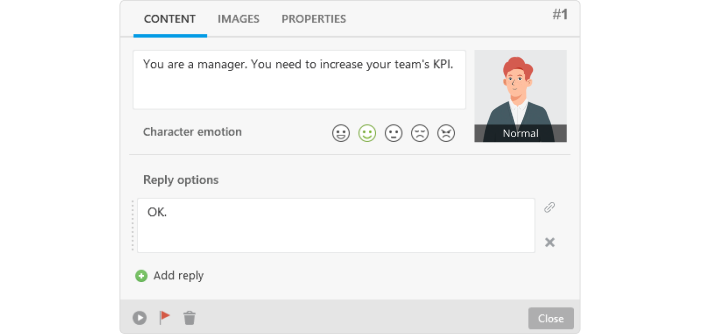
iSpring Suite has an extensive built-in library of ready-made content that includes all sorts of characters, their emotions, and backgrounds.
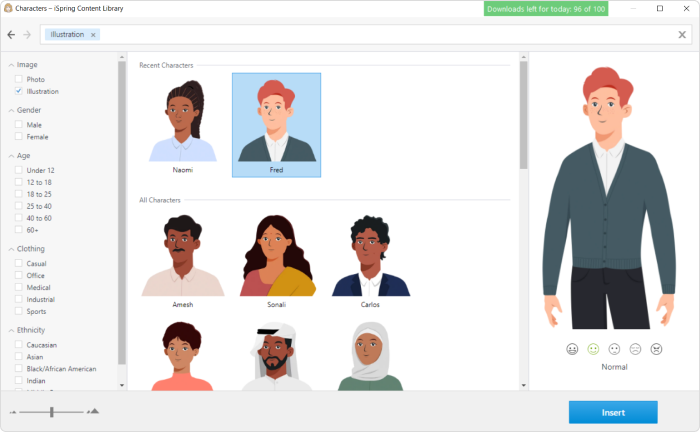
So, you can simply select the images that fit your sim the best. Or you can upload yours, if necessary. This is not a bad thing to understand how to do. iSpring makes it very easy to upload your own characters.
5. Create the next scene in the same manner. Then link them together. To do this, click on the link icon in the right corner.
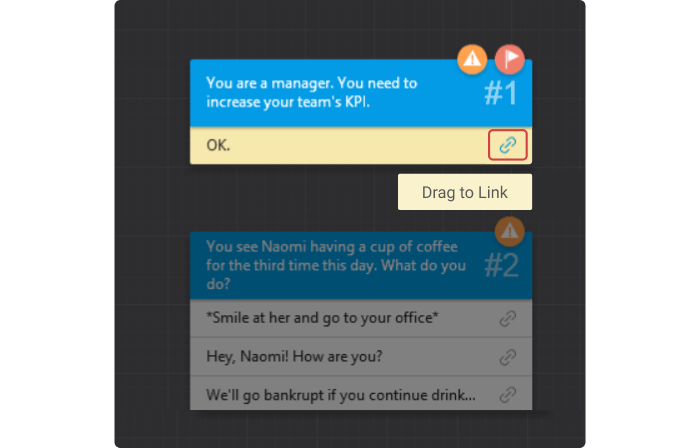
And drag the arrow from the first scene to the second one.

To make sure everything works exactly as you want it to, click Preview. If the creation process seems complicated to you, see the screenshots of the sim I developed while preparing this guide. It literally took me just a few minutes.

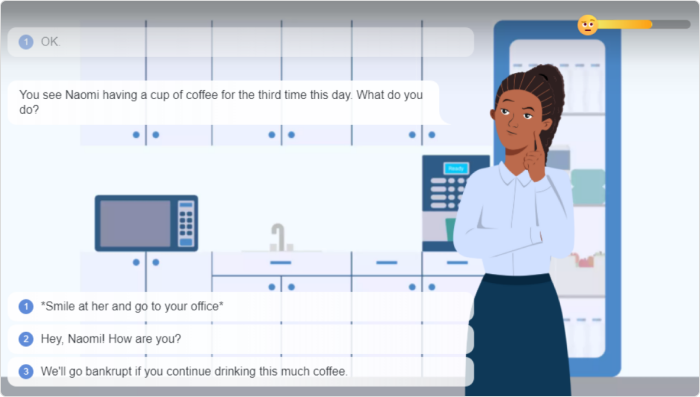
Feel free to customize the sim, including removing the emotion meter.
6. Create all the scenes of your sim in the same way and link them together.
Regardless of whether you create a simple or a complex sim, it all comes down to this: create a new scene and link it to the other scene(s). The final result might look something like this:

Step 4: Work on the Interface
8 hours
Now that you have the foundation of your sim, it’s time to polish it. First, smooth out the language. Then build out all the decisions.
Allowing learners to make mistakes
Your sim has to mirror the real world in terms of the mistakes people make. You should try to make your decisions focus on common mistakes that accurately represent the thinking that leads people down incorrect paths.
So, if you’re making a healthcare sim about washing hands, you might construct this choice:
You’re leaving one patient’s room and heading directly into another’s patient’s room. What do you do?
A. Wash your hands twice. Once when leaving, and once when entering.
B. Wash your hands once, when entering the new patient’s room.
The incorrect decisions is not obviously incorrect, and it is even sympathetic to why a person might make a mistake. In a perfect situation, a novice should be confused, while an expert understands an absolute right and wrong answer.
After these decisions are done, you might then choose to add some more decisions to your sim. If, for every example in your sim, the right answer is “wash your hands,” you can include a few decisions where the right answer is not to wash your hands. For example, “You leave a staff meeting and head to your car. Do you wash your hands or not?”
Then add a coach character to give feedback.
Step 5: Design graphics
11 hours
First, check the library of ready-made content in iSpring Suite. There, you can find the characters and backgrounds for most cases. Feel free to switch backgrounds for a sense of movement. You can start in your office (background: office), drive to a customer location (background: road), and then go visit a client (background: meeting room).

But the more you build sims, the more you’ll want to add custom graphics. This might be a chart or graph that changes during the course of your sim. It may be a single object against a white background. Or it might be both. Again, iSpring Suite makes this very easy.
When I create custom graphics, I do it in PowerPoint. For most of the Short Sims I make, I have a PowerPoint deck of slides that contains all of the graphics. I use the “Save as JPEG” command in PowerPoint and then import them into TalkMaster.
Power tip: Make sure you make the resolution of the slide deck match the resolution of the sim, which is usually 960X600.
This sounds hard but you can do it really quickly with a bit of practice.
Once again, look at my examples to see a variety of instances of using custom backgrounds.
Step 6: Polish your role-play
4 hours
Preview your sim and check to see if everything’s working. Perform the final scrubbing of the structures, graphics, and language.
Power tip: Every time you go through your sim, take out words. Wordiness kills sims.
Step 7: Review and update
5 hours
Publish your role-play to iSpring Cloud and send a link to stakeholders. Ask them to provide specific feedback. Based on the feedback, update your role-play and deliver the final version.
Here may be the most important design philosophy of all: the easier your sim is to change, the more you will want to hear stakeholder feedback.
And that’s it! Your role-play is all set to teach and engage learners!
Your #1 Tool for Creating Role-Plays
Create your first sim today. With iSpring Suite, it’s easy.
3 Tips for Sim Designers and Companies
My many years of experience working with clients and teaching sim designers have taught me a few ground rules that I believe are extremely useful for all people who want to create and use role-plays in their training.
Start with off-the-shelf sims
If you’re an L&D specialist in a company, you know how it goes. People come knocking on your door saying: “I want you to create some content for me, and I know all about workbooks. So why don’t you create a workbook?”
At that point, you might want to say: “I think you should use Short Sims instead because it will have better results. Your learners will like it more and, by the way, it will change behaviors more.”
But you know that if you say that, they’ll then ask: “Well great. Let me see some of these things that you’re talking about before I decide to do it.” If you’re just starting out, that will be awkward.
Now, imagine that you’ve deployed off-the-shelf sims on leadership, for instance. Then you say: “You’ve heard all this great feedback that we got from our leadership on the new management program. Well, that’s what I’m talking about.”
Play with a bunch of good sims
If you want to build Short Sims yourself, the most important thing to do is to play around with a bunch of them first. Otherwise, it’s like trying to make a movie before you’ve ever seen a movie. Or write a novel before you’ve ever read a novel.
A great learning experience, then, is to take a sim you like, open it up, and look under the hood to see how it works. Then start making small changes to that sim and then see how that plays out.
It is for that reason that when I sell Short Sims to clients, either off-the-shelf or custom, I include the editable sim file and the graphic files. I want my clients to be able to make small changes, update and evolve them, and ultimately build their own.
Keep it simple
Don’t use your intelligence to create a complicated narrative. Instead, use your intelligence to make an interesting example with clear, interesting choices and visuals.
Half of the sim design process is about how simple you can make it. Keep focusing on the simplicity of the situation until you have a working prototype. And then, once you do that, add the complexity to make it richer.
Create Training That Works
Short sims really work. And old stuff doesn’t. We all know that lectures, workbooks, and PPT presentations are pretty dull. We are never excited to create them. And learners never want to learn from them.
I’ve built over a hundred Short Sims for clients. I consider my best result to be the fact that my clients come back to me again and again and want more Short Sims. They say that sims worked so well that they want to scale this practice to other departments and topics.
Part of the success of role-plays is that they aren’t risky – unlike a lot of new technologies. Role-plays are safe and predictable in terms of the time frames for developing them and learning outcomes.
Also, role-plays can be edited very easily. If you see something you don’t like in a sim, like a graphic or language, you can go and edit it in no time. iSpring Suite is a superb tool for advanced, yet quick and easy, simulation design.
But most importantly, it’s the content that learners love. They’re comfortable taking sims to learn new skills and knowledge, and have no issues about applying them to their roles because this training content is so interactive and practical.
So, if you’re not satisfied with the current state of your training, consider adding role-plays. And over time, you’ll find they establish a stronger foundation for your learning and development. Soon, your culture may become “sim-first,” assuming every new training program will be made up mostly of sims. Soon you will wish that you had started shifting to sims earlier, to future-proof your content.
Endnote
If you’re interested to create sims yourself, test-drive iSpring Suite for free.



